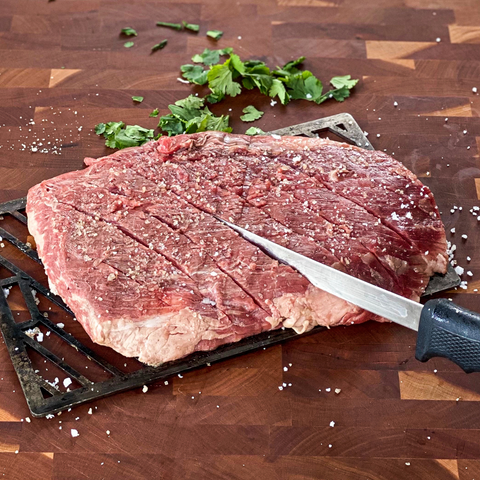Steak Buying Guide – Discount Edition

It’s really hard to save money on the big four steaks – Tenderloin, Ribeye, NY Strip and Porterhouse. Those cuts are expensive for a reason. Being low on funds doesn’t mean that steak is out of the question. We just have to look outside those expensive cuts and find an alternative. Luckily there are lots of options that have a ton of flavor that don’t cost a kidney. If funds are tight, scroll down through the Steak Buying Guide – Discount Edition.
Teres Major is not a Constellation
Despite the name sounding like a constellation in the sky, it’s an amazing cut of beef. Teres Major is not a huge steak, typically not much bigger than twelve ounces:


Many argue that the Teres Major is the second most tender cut of steak behind beef tenderloin/filet mignon. And while being tender it actually has some fat content so it is not as bland as the filet. An interesting aspect of the Teres Major is that the steak puffs up while cooking and actually gets thicker, albeit the length drops a little. Many restaurants serve this as steak medallions and most people assume it’s filet mignon. It is known by many names such as bistro steak, bistro tender, petite tender, and petite shoulder tender.
Flat Iron Steak
The flat iron is comprised of two muscles, one of which is the teres minor. This steak is also debated as the second most tender steak on the cow. The flat iron is aptly named since it is really flat, and fairly thin:

It is hard to put a good sear on a flat iron and keep rare or even medium rare. Many go a level higher than their preferred doneness to medium rare or even medium to get a proper sear on the flat iron. With as tender and juicy as this steak is, the extra doneness does not hurt too much.
Chuck Eye
The chuck eye comes from the very end of the primal ribeye and is limited to only two of these steaks on every cow:


The chuck eye lacks any spinalis, but otherwise is just like a ribeye at a fraction of the price. The biggest problem with the Chuck Eye is that meat cutters know how good these are and often purchase them for themselves before they ever hit the meat case.
Flank Steak (or Skirt Steak)
These thin cuts don’t have the same flavor as the big four steaks but
it is easy to kick up their flavor profile:


Lay these out flat, dust with some seasoning then top with spinach and cheese, roll them up and reverse sear before carving into medallions. Even doctored up, these steaks will still go easy on the wallet. Flank steak (or Skirt Steak) also make great steak tacos or fajitas. Drop them in a zesty marinade for twelve hours, do a quick sear, slice across the grain and you will be living the culinary dream!
Picanha
The primal sirloin cut is one of the larger cuts on the cow and along the top we find the picanha. This sirloin steak is usually carved with a thick layer of fat along the outer edge and often cooked on skewers that allow the steaks to be curled into a C shape so the fat layer forms the outside of that C.


When grilling these, make sure to hold that outer edge of fat close to the coals or put them right a hot grill grate or griddle to crisp up the fat.
Tri Tip Roast
Tri Tip is also from the sirloin. This one comes from the opposite end from the Picanha and usually weighs in at 1.5-2.5 pounds. The triangular shape gives this roast its name:


This cut was ground into hamburger until the cowboys and ranchers in the Santa Maria district of California requested them from the local butchers to save money. They simply seasoned them with salt, pepper, garlic, and paprika then roasted over fire on open air grills with a grill grate that raises and lowers to adjust temps which is now known as a Santa Maria grill. Both the roast and the grill are becoming more and prevalent throughout the country. One note, the muscle runs two different directions in the Tri Tip and needs to be sliced two ways. Slice it down the middle and slice the two remaining sides across the grain.


